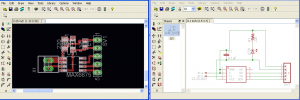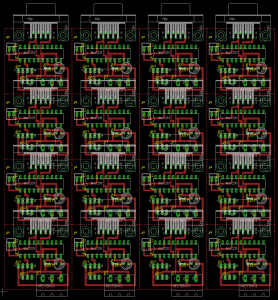I created a little SMT board for the MAX6675 thermocouple amplifier in EagleCAD if anyone out there is in need of a board. It’s very simple layout but it is a bit noisy, definitely expect to average samples coming from this chip (/board?). Other improvements would be adding a thermistor as the CJC (cold junction compensation) on the board so you can accurately offset the junctions at the board where you break the thermocouple wire and transition over to copper (which creates another TC junction unintentionally so you must compensate for it).
Tag Archives: EagleCAD
EagleCAD Panelize / Copy and Paste in Board View
Took too long to figure this out. EagleCAD of course likes to keep the schematic and the board synchronized, and it won’t back annotate edits on the board into the schematic. These are all happy, logical things that keep board designers sane. However! When it comes time to panelize or make multiple copies of a board layout for printing it won’t allow you to copy and paste sections of the board because it doesn’t want to perform the backannotation.
It took me a while of searching, but Keith’s Electronics Blog makes it sound like a cake-walk, it’s not that easy. However, a random forum post gets it right:
Open your first file
Execute panelize.ulp
[It's in the top bar, icon with ulp in black text on a white "sheet of paper"]
Group
Cut (don't forget origin click)
Open your other file
Save as different file name
Execute panelize.ulp
Paste the other board in [the part you're trying to panel that you previously "cut"]
EagleCAD Layout – Arduino Base
If you’re looking for an Arduino basic layout in EagleCAD (all clock/power/ICSP lines run but nothing else) here it is:
The board layout is troublesome on a single layer board, most of the I/O are currently blocked with power or ground, I’ll leave that up to you to figure out what you want to do.
If you’re looking at this, you’ll probably be really interested in this single sided Arduino layout.

